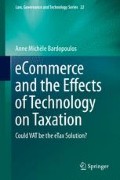Abstract
The fundamental principle of VAT remains invariable – VAT is an indirect taxing system which is based on consumption. VAT is levied on goods and services consumed by the taxpayer whereby the end user bears the brunt of the tax as it is a ‘consumption tax’.
The European VAT system provides an excellent example of harmonization. Several Southern Hemisphere countries have adopted a variation of the New Zealand VAT legislation. Canada imposed both retail sales tax and VAT systems, and in some provinces a harmonized VAT system which is effectively both retail sales tax and VAT imposed together. The Japanese consumption tax has departed from the EU VAT system. The above specified VAT systems represent the basis of all implemented VAT systems.
A point at issue is that a small variation in legislation may cause diverse implications and application of VAT legislation in respect of the virtual world.
The investigation of VAT as a possible eCommerce taxing solution should of necessity probe the effectiveness of eTransaction VAT collection and the effectiveness of the monitoring of VAT in eCommerce, and the application of VAT in the virtual world.
The art of taxation consists in so plucking the goose as to get the most feathers with the least hissing” – Ascribed to Jean Baptist Colbert (“French statesman, chief minister to Louis XIV (1665–83). A vigorous reformer, he put order back into the country’s finances, boosted industry and commerce, and established the French navy as one of the most formidable in Europe. His reforms, however, could not keep pace with the demands of Louis’ war policies and extensive royal building programme, and by the end of Louis’ reign the French economy was again experiencing severe problems.” [op cit,Oxford English Reference Dictionary, (Second Edition), (1996), USA. p282]) (1619–83)
Access this chapter
Tax calculation will be finalised at checkout
Purchases are for personal use only
Notes
- 1.
A practical review of the VAT history, development and various VAT liability calculating methods was covered in my M.Phil in Commercial Law, Part II Dissertation – material derived from the aforementioned dissertation will be used to introduce and promote the understanding of VAT, and will be expanded where necessary.
Bardopoulos, A. UCT M.Phil in Commercial Law Dissertation: VAT Implications in E-Commerce from a South African Perspective (2009).
- 2.
op cit Schenk, Alan & Oldman, Oliver Value Added Tax, A Comparative Approach (2007), USA, P58.
- 3.
New Zealand’s indirect legislation, the New Zealand Goods and Services Tax Act, No. 141 of 1985 (as amended), otherwise referred to as the GST Act, is the New Zealand VAT equivalent legislation.
- 4.
op cit Schenk & Oldman, p58.
- 5.
op cit Schenk & Oldman, p58.
- 6.
- 7.
Chang, Jacqui, Sales Tax Holiday May be Over for Amazon, Other E-Tailers (13/01/2009). Available at http://arstechnica.com/tech-policy/news/2009/01/sales-tax-holiday-may-be-over-for-amazon-other-e-tailers.ars [Accessed 22/03/2010].
- 8.
Harley T. Duncan State and Local Retail Sales Taxes, Federation of Tax Administrators April 2005, p1. Available at http://www.taxadmin.org/fta/rate/taxreformpanel.pdf [Accessed 27/03/2010].
- 9.
The United States House of Representatives website provides the following description of ‘Congress’:
‘All Legislative Powers herein granted shall be vested in a Congress of the United States, which shall consist of a Senate and House of Representatives.’
(Article I, Section 1, of the United States Constitution)
The chief function of Congress is the making of laws. The legislative process comprises a number of steps, and much information is available from this page concerning the legislation introduced and considered in the 111th Congress. To help you understand the information and how it interrelates, a very brief overview of the legislative process within the House of Representatives is presented below. There are many aspects and variations of the process which are not addressed here…The work of Congress is initiated by the introduction of a proposal in one of four principal forms: the bill, the joint resolution, the concurrent resolution, and the simple resolution.
United States House of Representatives. Tying It All Together: Learn about the Legislative Process. Available at http://www.house.gov/house/Tying_it_all.shtml [Accessed 13/12/2010].
- 10.
United States Sales Tax Site: Sales on the Internet. Available at http://www.usa-sales-use-tax-e-commerce.com/sales_on_internet.asp [Accessed 2/12/2010].
- 11.
Imposition of goods and services tax on supply in terms of Section 8 of New Zealand Goods and Services Tax Act 1985 141.
- 12.
Section 11(2)(k) of the South African VAT Act, No. 89 of 1991 (as amended).
- 13.
Some VAT systems offer a multi-tier rate system. Zero-rated supplies are still taxable supplies but merely subject to VAT at 0 %.
Bibliography
Primary Sources
Statutes
New Zealand Goods and Services Tax Act, No. 141 of 1985 (as amended).
South Africa Value-Added Tax Act, No. 89 of 1991 (as amended).
Secondary Sources
Bardopoulos, Anne. 2009. VAT implications in e-Commerce from a South African perspective. University of Cape Town Masters of Philosophy in Commercial Law Dissertation.
Chang, Jacqui. Sales tax holiday may be over for Amazon, other e-Tailers (13/01/2009). Available at http://arstechnica.com/tech-policy/news/2009/01/sales-tax-holiday-may-be-over-for-amazon-other-e-tailers.ars. Accessed 22 Mar 2010.
Duncan, Harley T. State and local retail sales taxes, federation of tax administrators April (2005). Available at http://www.taxadmin.org/fta/rate/taxreformpanel.pdf. Accessed 27 Mar 2010.
Schenk, Alan, and Oliver Oldman. 2007. Value added tax, a comparative approach. New York: Cambridge University Press.
The Oxford English Reference Dictionary, 2nd ed. 1996. New York: Oxford University Press.
United States House of Representatives. Tying it all together: Learn about the legislative process. Available at http://www.house.gov/house/Tying_it_all.shtml. Accessed 13 Dec 2010.
United States Sales Tax Site: Sales on the Internet. Available at http://www.usa-sales-use-tax-e-commerce.com/sales_on_internet.asp. Accessed 2 Dec 2010.
Author information
Authors and Affiliations
Rights and permissions
Copyright information
© 2015 Springer International Publishing Switzerland
About this chapter
Cite this chapter
Bardopoulos, A.M. (2015). Introduction. In: eCommerce and the Effects of Technology on Taxation. Law, Governance and Technology Series, vol 22. Springer, Cham. https://doi.org/10.1007/978-3-319-15449-7_15
Download citation
DOI: https://doi.org/10.1007/978-3-319-15449-7_15
Publisher Name: Springer, Cham
Print ISBN: 978-3-319-15448-0
Online ISBN: 978-3-319-15449-7
eBook Packages: Humanities, Social Sciences and LawLaw and Criminology (R0)

